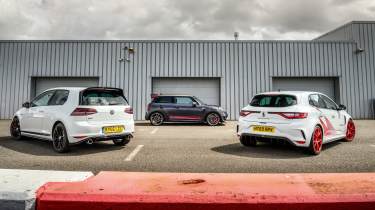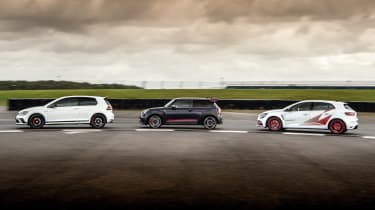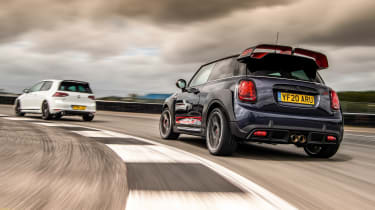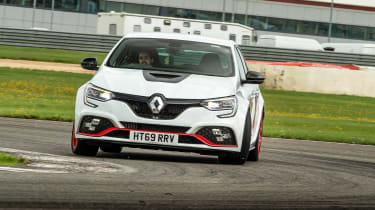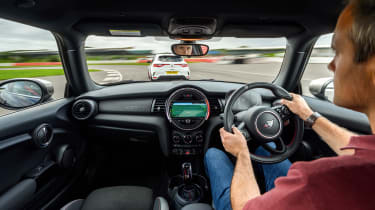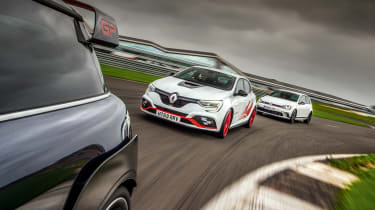Mini JCW GP v Renault Mégane RS Trophy-R v Volkswagen Golf GTI Clubsport S
It’s got them covered on paper, but has Mini’s latest Works GP got the moves to outperform Renault’s rival Mégane RS Trophy-R and VW’s benchmark Golf GTI Clubsport S?
These are the elite of hot hatchbacks. Not necessarily the fastest in a straight line, but the warriors ruthlessly trimmed down to their optimum fighting weight, with months clocked up in the gym and superberry smoothies in their tanks. Consider today, then, a welcoming party for Mini’s latest and third entry into this, the slenderest of market segments. The company’s 2006 Cooper S Works GP was arguably the initiator of this breed of trackday-focused hot hatch, vehicles with two seats and scaffold bars of some description that owe their raison d'être to non-competitive driving on track, rather than an outright mission brief for motorsport as once epitomised by Rallye-model Peugeots, or indeed Rallyes from Volkswagen.
Of course, the car we all instantly think of when it comes to such a device is the Mégane R26.R, and in recent years it’s the French machinery that has dominated this sector, with perhaps the exception of another car we have present here, the 2016 Volkswagen Golf GTI Clubsport S. Based on the Mk7 GTI, this two-seat wunderwagen blitzed not only the Nürburgring, where it lowered the hot hatch record to an absurd 7min 49sec, but also eCoty in the same year, famously clinching the runner-up spot.
> Mini JCW GP 2020 review - Mini sharpens up ready to rival GR Yaris
That mention of being two-seat only is worth pausing on for a moment. Traditionally, no one gains entry to this exclusive club unless they’ve stepped across the Maginot Line of hot hatchdom: to sacrifice a tenet of the original hot hatch idea – practicality – in search of lower mass and, hence, greater circuit ability. It’s a pivotal moment, because in doing so you end up with the obvious compromises of a front-wheel-drive, hatchback-based performance car, with the same occupant capacity as an outright sports car, itself purpose-designed for speed and driver satisfaction. Any hot hatch that takes the leap had better deliver in the entertainment stakes, or else…
We all know that the Golf is great. As I drive to our test location, Silverstone's Stowe circuit (currently home to Aston Martin), the memories of an extraordinary car come flooding back: the instant, any-rev response of the 306bhp EA888, the keenness that only saving the kilos can imbue. We already know, too, that ‘Hardcore Mégane Take 3’ is not without problems of its own, for all Renault Sport’s reputation and the car’s dazzling performance. As much as the Golf thrilled in eCoty 2016, the Mégane Trophy-R in full-spec, £72,140 form, with carbon-ceramic brake discs and carbonfibre wheels, failed to really hit the mark in eCoty. It simply proved a frustrating machine – brilliant on track, eternally hit-and-miss on the road. Here we’re using the non-carbon car, at a still pricey £51,455, and moreover Renault has attempted to answer our criticisms of its on-road behaviour by tailoring its set-up to British roads. Will this be the golden key that unlocks its undeniable potential? Don’t forget, it’s the current Ring lap record holder, with a time of 7min 40.1sec.
First though, to the newcomer: the Mini. I park the Golf next to it in the pitlane at Silverstone and stare in puzzlement for a moment. Looks, as ever, are subjective, but for me this is a design that sends one eyebrow sky-high; on one hand brazenly aggressive (that rear wing) and on the other with some bizarre features (those flat-pack wheelarch extensions, that entirely fake bonnet vent). It’s powered by the familiar BMW B48 engine, arguably one of the most charmless 2-litre turbocharged units ever made, albeit, I concede, an effective one. This is no ordinary B48 though, because in this 302bhp form it uses a reinforced crankshaft, new pistons, and runs more boost from a bigger turbo. It’s the 332lb ft that really catches the eye, but then again this Mini is far from being mini in all senses of the word. However, it does endow the GP3 with fearsome acceleration, 0-62mph covered in just 5.2sec and the car running all the way unfettered to a maximum speed of 164mph – the fastest out-of-the-box car in the BMW Group. The motor is connected to an eight-speed torque-converter gearbox and deploys drive through a mechanical limited-slip differential, with a chassis that’s wider in track, 10mm lower than a regular JCW, and whose metal and harder rubber bushings are partnered with a more aggressive geometry set-up for the suspension. This latest JCW GP weighs 1255kg, and 575 of them are earmarked for the UK out of a total production run of 3000.
I head out onto the circuit, perched on a slightly underwhelming sports seat, my fingers on the paddles ready to take control of the gearbox, a couple of slower laps ahead to get some heat into the tyres, and… this all just feels weird. The lack of interaction given no manual ’box is a strange sensation in a small, tightly focused hot hatch. Sure, the grown-up fast ones usually now have twin-clutchers, but Clubsport S, hot Méganes, Civic Type R – they all feature a stick and three pedals, and can you imagine a Fiesta ST without them? That keen sense of involvement is a hot hatch staple, and without it the driving experience feels a lot quieter – intensifying the brain’s scrutiny on other areas.
The real issue here is that a torque-converter is absolutely not the stuff of hot hatch dreams. It doesn’t have the positivity and response of a DCT, but worse is if you let the revs get near the red line. Now, despite pulling the paddle, you’re stuck in a no man’s land, waiting for the next gear to select after a yawning gap, the engine hanging on to its maximum revolutions in a tuneless wall of noise. I make a significant mental note to upshift a little earlier than my ear suggests would be wise, and concentrate on the torque steer instead.
The track is not the smoothest of layouts, but out of the hairpin the Mini likes to kick back through the steering, and there’s even more of a torque reaction under heavy braking, where you’ve got to keep a firm hand on the car’s trajectory. It’s quite a handful; the motor feels punchy, the brakes capable, while the steering has that love-it-or-loathe-it Mini staple of a very quick ratio just off the straight-ahead to induce some of the hyperactive feel inherent in smaller Minis of ten and fifteen years ago. Hmm.
By contrast the Mégane has got you by the throat, dangling a metre off the ground, from the very first lap. On cold Bridgestones it has to be the most sideways front-wheel-drive car – possibly any sort of car full stop – that I can recall. It’s like an old Super Tourer before the tyres have ‘come in’, a serial oversteer merchant if you so much as think about lifting off the throttle. The angles it’ll go to – admittedly recoverable – are extreme (with the ESP switched off), and they’d certainly focus the mind on a wet winter’s morning commute. Once that rubber has come up to temperature the Mégane is awesome, just as the full-spec car was at Ascari last autumn. Because it works the rear of the car so much, understeer is all but banished from the Mégane’s vocabulary; the front dives in, you can manipulate it if desired by a lift of the throttle, and pretty soon the car is pointing straight, directly through and out of the corner, allowing you to use every last bit of the fizzy 1.8-litre’s power onto the next straight. Rarely has any car felt so at home on a circuit, for like anything that excels in this environment it feels happy here, exuding endurance, looking after its brakes and tyres even when pushed hard.
Unfortunately our Golf today is equipped with the alternative OE tyre – a Pirelli P Zero – to the Michelin Pilot Sport Cup 2 all previous examples we have tested have been fitted with. Yet despite the change of footwear the qualities of the Clubsport S are obvious: the way it feels so light and agile, so up on its toes, but bizarrely at the same time with that typical Mk7 Golf polish that almost seems at odds with a two-seat track car. Old Pirellis are not a good partner for the diff to work with, though, so there’s plenty of wheelspin leaving the tighter corners, and understeer rather than tail-led heroics through the faster stuff because they just won’t dig in and allow the tail to rotate, but the cool precision of the steering and the essential rightness of the package are evident. These are still road cars though, and heading out onto some classic English country lanes soon filters the pack more clearly.
The Mini is the first to fall here and, sadly, from quite a great height. I think it’s fair to say that editor Stuart Gallagher detests it, and as much as I search for the good in it, I’m afraid I just can’t get it to resonate as a package with me at all. On closer inspection those unusual track width extensions (what to actually call them?) look like something knocked together for a GCSE CDT project and appear to be held on by sticky pads. They’re actually made of recycled parts of i3s and i8s, but the Mini’s visual busyness is in stark contrast to the simplicity of a genuine homologation special of the moment, the Toyota GR Yaris. There is no adaptive damping, and where sometimes such purity of focus can be a good thing, in the GP3 that simply means the ride is very unyielding, and on poorer B-road surfaces a hindrance to fast driving. Predictably, that also means the diff struggles to deploy all that 332lb ft of thrust, meaning plenty of torque steer, and the gearbox… oh, the gearbox. Come on BM… sorry, Mini, we know you still have some fine manual gearboxes – the M2’s, for example…
Cars are always a product of where they are born, and I don’t doubt the GP3 will be effective at the Ring, and it’s surely enjoyable too flicking it into Hohe Acht with a GT3 RS gasping for pace in the mirror. But the execution simply doesn’t work on our roads: it’s uncomfortable but often ineffective with it, and the very notion of having a hot hatch with a slusher ’box is a mix even Heston Blumenthal would struggle to perfect. It feels artificially nervous and manic one minute, dull and uninvolving the next, and captures little of the pint-pot loony spirit characterised so well by the first two GP models. Frankly, its qualities and components seem so disparate to each other that it’s a struggle to effectively sum up what is one of the strangest and most disappointing cars we’ve driven for some time.
As for the Renault, its problem is perhaps that it’s too focused on one target. It feels like a ruthless exercise in making a large five-door hatchback lap the Ring in almost exactly 7 minutes and 40 seconds of blistering commitment, but something, somewhere, very important has been sacrificed in the process. The old R26.R was an equally brilliant – if slower – car on track, but it was also the sort of machine that you’d want to drive down your favourite B-road, just for the sake of it, again and again. As we said during our first drive of this reconfigured Trophy‑R (evo 278), the changes to the suspension are a significant step in the right direction, the car no longer hopping from bump to bump and much better able to deploy its 296bhp without hunting all over the place, but it’s still a fight if the road isn’t smooth. Sometimes that can feel like highly charged fun, other times like you’re having to force the car to do something it doesn’t want to do, a sentiment that could be applied to the gearshift quality as well. There are still too many occasions when a corner is something merely to be completed, rather than an exercise in entry, line and exit. I greatly respect the Trophy-R for what it can do, but at this price point in particular, I don’t yearn to own one.
So it’s the old-timer that takes the plaudits because real class doesn’t date. Although it’s nearly ten seconds slower than the Mégane around the Nordschleife (and half a second slower around Bedford Autodrome’s West Circuit), in reality it’s only a small percentage off the Mégane for on-track ability and pace. And yet in return it’s a much more multitalented, multitextured sort of car, far more at home on the road. In fact, you could quite easily use it as a daily – not that it’s the most practical of hatchbacks, but at least having a hatch with only two seats makes more sense in a three-door shell. Being able to soften the adaptive damping works wonders, and there’s never a moment when the S feels out of its depth. It’s one of those rare cars where the more challenging the road, the more it rises to the occasion, so the more you just want to keep driving it.
The customer base for a two-seat hatchback that only really works on the circuit but costs nearly Cayman GT4 money is tiny, but the market for one costing just over half that price and which is also a cracking road car is significantly bigger. For now, VW still rules.
Specs
| Volkswagen Golf GTI Clubsport S | Mini John Cooper Works GP | Renault Mégane RS Trophy-R | |
| Engine | In-line 4-cyl, 1984cc, turbocharged | In-line 4-cyl, 1998cc,turbocharged | In-line 4-cyl, 1798cc, turbocharged |
| Power | 306bhp @ 5800-6500rpm | 302bhp @ 5000-6250rpm | 296bhp @ 6000rpm |
| Torque | 280lb ft @ 1850-5700rpm | 332lb ft @ 1750-4500rpm | 295lb ft @ 2400-4800rpm |
| Weight | 1285kg | 1255kg | 1306kg |
| Power-to-weight | 242bhp/ton | 244bhp/ton | 230bhp/ton |
| 0-62mph | 5.8sec | 5.2sec | 5.4sec |
| Top speed | 165mph | 164mph | 163mph |
| Price new | £33,040 | £33,895 | £51,455 |
| Value today | £34,500-37,000 | na | na |
This story was first featured in evo issue 280.

